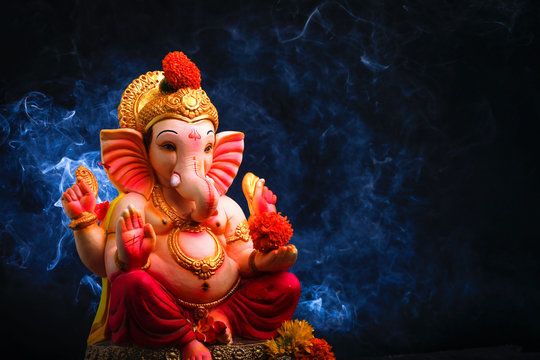Summary
Biography
Origins and Symbolism of Ganapati
Ganapati’s identity is rooted in rich mythology. According to the most well-known tale, he is the son of the great goddess Parvati and Lord Shiva, one of the three supreme deities of the Hindu trinity. The narrative of his birth explains his unique elephant-headed form. Parvati created Ganesha from her own body, molding him out of turmeric paste and breathing life into him. She assigned him the task of guarding her chamber while she bathed. When Shiva returned and was denied entry by this new guardian, he was enraged and, unaware of the boy’s origins, severed his head after a fierce battle. Upon realizing his mistake, Shiva promised Parvati that he would restore Ganesha to life. The head of a young elephant was offered as a replacement, making Ganapati both human and divine, embodying the union of strength and softness, dominance and humility.
This symbolism makes Ganapati an extraordinary deity. His elephant head represents wisdom, knowledge, and memory. The large ears indicate attentiveness to prayers and teachings, while his small eyes emphasize focus and concentration. His curved trunk is a metaphor for adaptability and efficiency, capable of both uprooting trees and plucking delicate flowers. His large belly is believed to represent the capacity to digest both the joys and sorrows of the world. Each aspect of his imagery reveals a spiritual lesson meant to guide devotees in their daily lives.
Ganapati in Hindu Philosophy
Ganapati holds a very special position in Hindu philosophy as the "Vighnaharta," or remover of obstacles. This quality explains why nearly all Hindu rituals begin with prayers to him. Before starting any endeavor—a marriage, a business venture, journeys, or even learning—devotees invoke Ganapati to ensure an unhindered path toward success. His association with intellect is another reason students and scholars worship him for knowledge and clarity of mind.
According to Vedic scriptures, Ganapati’s role also extends to cosmic order. He is considered the lord of beginnings, guiding energy along its proper course. Without his grace, it is believed that divine energy cannot flow freely. In tantric traditions, he is linked with the root chakra, symbolizing grounding and stability. His presence safeguards devotees from psychological and spiritual obstructions, allowing them to achieve higher states of consciousness.
Iconography and Worship
Ganapati’s iconography is multidimensional. Most depictions show him with four arms, though in some traditions he has six, eight, ten, or even thirty-two. These multiple arms symbolize his vast capabilities. In his hands, he often carries objects with deep meanings:
- Axe (parashu) represents the cutting away of ignorance and material attachments.
- Rope (pasha) symbolizes pulling devotees closer to truth and liberation.
- Modaka (sweet) indicates spiritual rewards and the sweetness of devotion.
- Lotus flower represents purity and the unfolding of spiritual awakening.
One of his tusks is broken, which itself carries various interpretations. Some stories say he broke it in battle, while others suggest he used it as a writing tool for the great Indian epic, the Mahabharata, which he transcribed while sage Vyasa dictated. Thus, his broken tusk symbolizes sacrifice in the pursuit of wisdom.
Ganapati’s mount is a small mouse, which at first seems surprising and contradictory, given his grandeur. However, it signifies how wisdom can ride even upon the smallest of creatures, and how spiritual mastery requires control over even the most restless thoughts. The mouse also represents desire, which can consume endlessly if unchecked, but under Ganapati’s guidance becomes subdued and directed.
Festivals and Celebrations
Among all Hindu festivals, Ganesh Chaturthi is the most significant celebration of Lord Ganapati. This festival, which usually occurs in late August or early September, marks his birthday. It is celebrated with grandeur in states like Maharashtra, Karnataka, and Andhra Pradesh, and has expanded across the world. For ten days, elaborately crafted idols of Ganesha are installed in homes and temples. Devotees offer sweets, flowers, and prayers, and communities come together in joyous processions. On the final day, the idols are immersed in water in a ritual known as Visarjan, symbolizing the cycle of creation and dissolution as well as the reminder that divinity resides within us even after the external form dissolves.
Ganapati Beyond India
Ganapati’s worship extends beyond India. In Buddhist and Jain traditions, he is revered as a guardian of sacred wisdom. In Nepal and Tibet, he is seen as a protector deity, while in Southeast Asia—Thailand, Indonesia, and Cambodia—art and temples feature his presence prominently. In fact, his image is also found in regions stretching to Japan, emphasizing how his role as the remover of obstacles and giver of abundance transcends cultural borders.
Feminine Aspects of Ganapati
Though often perceived through masculine form, Ganapati contains several qualities that align with the feminine divine principle. As Parvati’s son, he inherits her nurturing nature. His round, maternal-like belly, his kindness, and his inclination toward compassion reflect energies often viewed as feminine in spiritual traditions. Some tantric interpretations even view Ganapati as androgynous, a union of masculine and feminine forces harmonized within one being.
Spiritual Teachings of Ganapati
The lessons imparted by Ganapati are deeply practical and spiritual:
- Embrace wisdom over impulsiveness.
- Overcome obstacles with patience and resilience.
- Balance desire with discipline.
- Recognize unity in diversity, symbolized by his mixture of human and animal qualities.
- Accept imperfections, as symbolized by his broken tusk, while continuing to pursue higher truths.
Ganapati, therefore, is not just a god to be externally worshipped but also an inner guide. His presence in daily rituals reminds devotees that true divinity lies in self-mastery, humility, and compassion.
